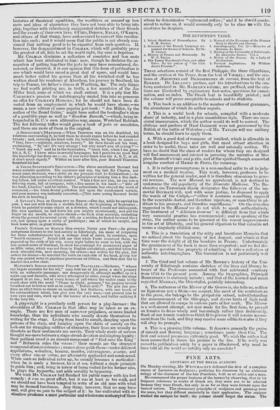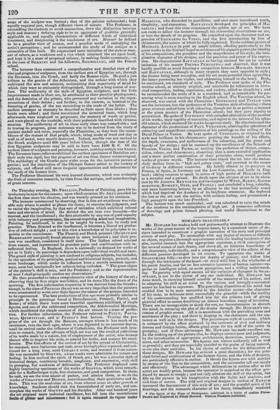FINE ARTS.
LECTURES AT THE ROYAL ACADEMY.
ON Monday evening, Mr. WEST MACOTT delivered the first of a complete course of Lectures on Sculpture ; prefacing his discourse by an elaborate eulogy of the character of the late President, both as an artist and a man.
He commenced the proper business of the lecture'by observing, that in his frequent reference to works of Greek art, they were not to be admired because they were Greek, but only , in so far as they were formed upon the basis of nature. The elementary principles of sculpture and paintiag were the same, but they differed materially in their application. The sculptor studied the antique for itself; the painter should forget the statue. The scope of the sculptor was limited ; that of the painter unbounded ; both equally 'required just, though different views of nature. The Professor, in counselling the students to avoid mannerism, drew the distinction between style and manner ; defining style to be an aggregate of qualities generally applicable to, and equally characteristic of different kinds of individual treatment, and designating it the touchstone of art. Manner he defined to be a peculiar view of nature, and a peculiar mode of embodying the artist's perceptions ; and he recommended the study of the antique as a corrective of this fault. He stigmatized mere imitation of the style or man- ner of others, as a weakness and a vice which returned the art upon itself, and kept it in a state of perpetual infancy, by making faults systematic,—as in the case of BERNINI and his followers, ROUBILLIAC, and the French school.
The lecturer then commenced a comprehensive and detailed view of the rise and progress of sculpture, from the earliest wra of Egyptian art, through the Etruscan, into the Greek, and lastly the Roman style. He paid a just tribute to the genius of the Athenians, and the ardour with which they cultivated the arts and sciences, maintaining that superiority of mind for which they were so eminently distinguished, through a long course of war- fare. The uniformity of the style of Egyptian sculpture, and the little improvement made in their art, he attributed to their peculiar physiognomy, and the dominion of the priests, who prevented any variation in the repre- sentations of their deities ; and further, to the custom, ao inimical to the fostering of genius, of the son shcceeding to the trade of the father. The earliest attempts at statuary he described as little more than blocks ; then heads were added; and these constituted the terminal busts, which long afterwards were employed to perpetuate the memory of worth or genius, and were placed on the roadside, with their pedestals inscribed with virtuous maxims. The uniformity of art in those early times was remarkable; and in tracing its progress, great assistance was to be derived from the study of ancient medals and coins, especially the Phconician, as they bore the resem- blance of the statues of that people, which, being made of wood and clay as well as of metal, were mostly destroyed. Indeed, marble was not worked by
the Greek sculptors until 600 years before Christ, though the date of the first Egyptian sculptures may he said to have been 1500 B. C. Of the
earliest times of sculpture and painting, however, nothing certain was known. The Etruscan basso-relievos exhibited the earliest specimens of Dsedalian art: their style was rigid, but the progress of art was from thence uninterrupted. The mythology of the Greeks gave wider scope for the inventive powers of genius ; and the institution of the Olympic Games added to the variety of subjects, and offered still more frequent opportunities and inducements for the study of the human form. The Professor illustrated his very learned discourse, which was evidently the fruit of extensive research, by casts from the antique, and some drawings of great interest.



















 Previous page
Previous page